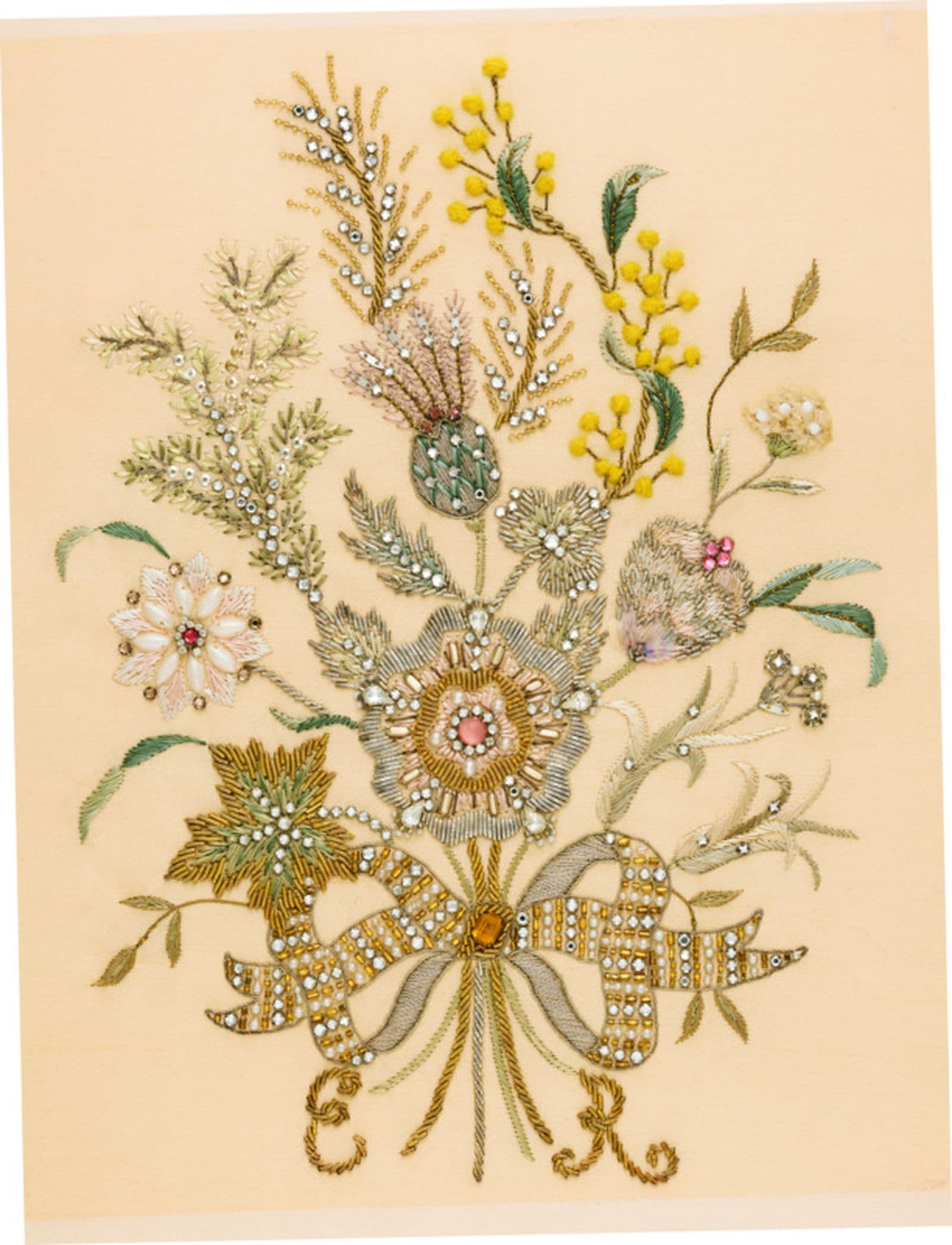By Appointment
Norman Hartnell’s sample for the Coronation dress of Queen Elizabeth II
1–30 Jun 2002

Norman Hartnell, Queen Elizabeth II Coronation gown embroidery sample, 1953, purchased 1986
About
On 2 June 1953 the world’s attention focused on the coronation of the young Queen Elizabeth in Westminster Abbey. It was the first royal ceremony to be televised and shared with the world. The carillon of bells rang out over London and Handel’s Music for the Royal Fireworks filled the Abbey, the young Queen wore a white satin dress designed by the royal couturier Norman Hartnell (1901–1979).
Hartnell was primarily a self-taught designer with a ‘precocious talent for drawing’. [1] He established his couture studio at 10 Bruton Street, London in 1923, which continued into the late 1960s. His clientele consisted of members of the peerage and celebrities including Barbara Cartland. She boasted of being his first customer in 1924, when she commissioned Hartnell to design dresses for a charity performance. His reputation for creating dresses of flair and glamour ensured the steady growth of his business, and by the time of the coronation he had 350 employees.
Queen Elizabeth commissioned Hartnell to design and make the Coronation dress in October 1952. Initially, Hartnell submitted eight designs for consideration from ‘almost severe simplicity and proceeded towards elaboration’. [2] After presenting them to the Queen, she showed her preference for the final sketch which incorporated the emblems of Great Britain in tones of white and silver but ‘suggested that I [Hartnell] might employ the aid of colour’. [3] The ultimate and ninth design included the emblems of Great Britain and the countries of the Commonwealth.
The emblems of the countries of the Commonwealth, which can be seen on the embroidery sample acquired by the Gallery in 1986, include the Tudor rose of England, the Scots thistle, the Welsh leek and the shamrock of Ireland complemented by the wattle of Australia, the maple leaf of Canada, the New Zealand fern, South Africa’s protea, a pearly lotus flower for India, a second opalescent lotus flower for Ceylon and Pakistan’s wheat, cotton and jute. The motifs on the dress were embroidered in pastel-coloured silks, pearls, diamonds, pale amethysts, golden crystals, gold and silver bullion and sequins to create a shimmering effect. There was one emblem not included in the embroidery sample that was included in the dress: ‘unknown to the Royal wearer there was one extra little four-leaved shamrock for luck.’ [4]
The finished dress was described by its wearer in one word – ‘glorious’. [5] It was ‘encrusted with seed pearls and crystals to create a lattice-work effect and had short sleeves, a fitted bodice and full skirt flaring out. The neckline, cut square over the shoulders, curved into a gentle heart shape in the centre. Three embroidered, jewel encrusted bands depicting the emblems of the United Kingdom and the countries of the Commonwealth ran like garlands horizontally across the skirt.’ [6] Every detail was done by hand in Hartnell’s studio taking nine weeks and 3,000 hours to complete.
On her way to Westminster Abbey, the Queen wore the George IV State Diadem, the diamond collet necklace made for Queen Victoria and matching diamond drop earrings and carried an all-white bouquet featuring orchids and lily of the valley from England and Wales as well as stephanotis and carnations from Scotland and the Isle of Man. Her shoes, made by Roger Vivier of Paris, were of gold curving strands of leather with heels encrusted with garnets. Afterwards, for her return to Buckingham Palace, she wore the Imperial State crown.
The brilliant effect of the Coronation dress is hinted at by this embroidery sample which in itself conveys freshness and harmony tempered with stateliness and dignity afforded by the luxurious materials and the exactitude of the embroidery. It provides a glimpse of an historic occasion and a dress which was again seen in Australia when the Queen wore it to open the Federal and State Parliaments during the 1954 Royal Tour.
Belinda Cotton
Ron Ramsey
1 Norman Hartnell, The Royal Pavilion, Art Gallery and Museums, Brighton, UK, 1985, p45.
2 Norman Hartnell, Silver and Gold, Evans Brothers Ltd, London UK, p. 123.
3 Ibid, p129.
4 Op cit.
5 Ronald Allison & Sarah Riddell, The Royal Encyclopedia, 1991 in Yvonne Demoskoff website, Coronation Trivia http://mypage.uniserve.ca/~canyon/ QEIICoronation_Attendants.html.
6 Majesty Volume 14, No.6, June 1993 1991 in Yvonne Demoskoff website, Coronation Trivia http://mypage.uniserve.ca/~canyon/QEIICoronationAttendants.html.
Tour
- David Jones Limited, Sydney NSW
13 – 25 August 2002 - Bathurst Regional Art Gallery
29 August – 15 September 2002 - Castlemaine Art Gallery & Historical Museum
19 September – 6 October 2002 - Gold Treasury Museum, Melbourne
10 – 27 October 02 - Queen Victoria Museum & Art Gallery, Launceston TAS
1 – 17 November 2002 - Tasmanian Museum and Art Gallery, Hobart TAS
21 November – 15 December 2002

